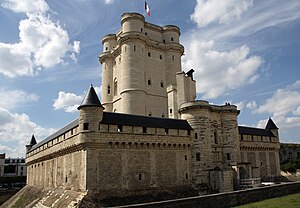


Enceinte (from Latin incinctus "girdled, surrounded") is a French term that refers to the "main defensive enclosure of a fortification".[1] For a castle, this is the main defensive line of wall towers and curtain walls enclosing the position. For a settlement, it would refer to the main town wall with its associated gatehouses, towers, and walls.
According to the 1911 Encyclopædia Britannica, the term was strictly applied to the continuous line of bastions and curtain walls forming "the body of the place", this last expression being often used as synonymous with enceinte.[2] However, the outworks or defensive wall close to the enceinte were not considered as forming part of it. In early 20th-century fortification, the enceinte was usually simply the innermost continuous line of fortifications.[2] In architecture, generally, an enceinte is the close or precinct of a cathedral, abbey, castle, etc.[2]
This definition of the term differs from the more common use of enceinte as a French adjective, which means "pregnant".[3]
- ^ Friar 2003, p. 105.
- ^ a b c . Encyclopædia Britannica. Vol. 9 (11th ed.). 1911. p. 368.
- ^ "Definition of ENCEINTE". www.merriam-webster.com. Retrieved 2022-03-13.